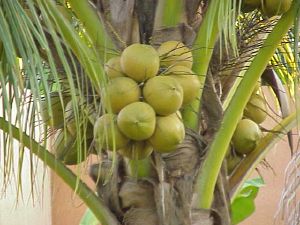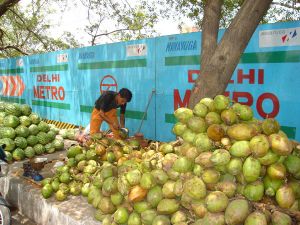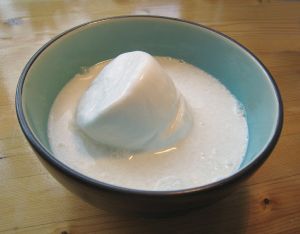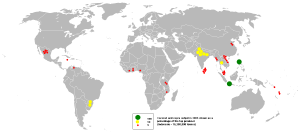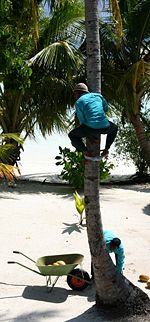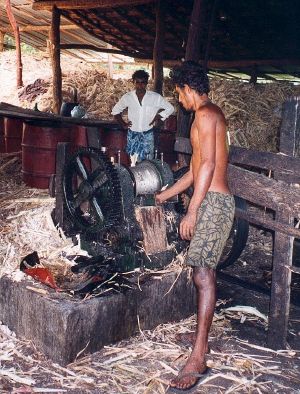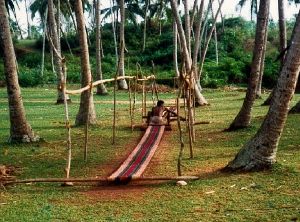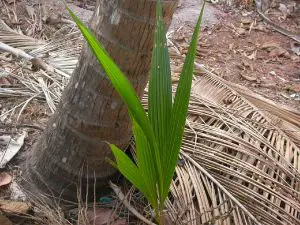Coconut
| Coconut | ||||||||||||||
|---|---|---|---|---|---|---|---|---|---|---|---|---|---|---|
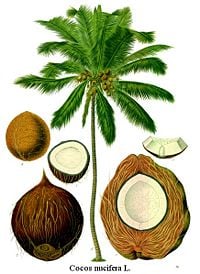 Coconut Palm (Cocos nucifera)
| ||||||||||||||
|
Secure
| ||||||||||||||
| Scientific classification | ||||||||||||||
| ||||||||||||||
| Cocos nucifera L. |
The coconut palm is species of palm tree, Cocos nucifera, that grows to about 30 meters tall and is extensively cultivated in tropical climates. It is one of about 2,600 species in the palm family Arecaceae and it is the only extant species in the genus Cocos.
The term coconut refers to the fruit of the coconut palm, which consists of a fibrous husk (mesocarp) encasing a large seed or inner stone. The term coconut also is used to refer to the entire large seed with its covering of hard, green, fibrous endocarp, or to the edible, commercially important, white and fleshy part of the seed (the coconut "meat" or endosperm), which in turn surrounds the hollow, fluid-filled, central cavity. The hollow center is generously filled with a clouded yet translucent, flavored liquid (liquid endosperm) slightly thicker in consistency than water.
While the origins of the coconut are subject to controversy, including areas of south Asia, northwestern South America,New Zealand, and India, it has spread generously across the tropics, thriving on sandy soils.
The coconut palm today is grown throughout the tropical world, for decoration as well as for its many culinary and non-culinary uses. Virtually every part of the coconut palm has some human use. For example, the white, fleshy part of the seed provides food; the coconut water provides a nutritious drink; the fiber left over from coconut milk production is used as livestock feed; the apical buds are edible ("heart-of-palm"); and the nectar is used to make a drink. Furthermore, the fiber from the husks is used to make ropes, brushes, and other items; the leaves are used for baskets and roofing thatch; the palmwood is used for furniture and construction; the trunk is used to make drums, containers and small canoes; and the roots provide a dye and medicine; among many other uses.
The Sanskrit name for coconut is kalpa vriksha, which means "the tree that provides all the necessities of life."
Description
The coconut palm has a straight, unbranched stem, with large, compound evergreen leaves that are pinnate, 4-6 meters long, with pinnae 60-90 centimeters long. The leaves are spirally arranged at the top of the stem. The old leaves break away cleanly leaving the trunk smooth.
The flowers of the coconut palm are radially symmetric and polygamomonoecious, with both male and female flowers in the same inflorescence. Flowering occurs continuously, with female flowers producing seeds. Coconut palms are believed to be largely cross-pollinated, although some dwarf varieties are self-pollinating.
The fruit
Botanically, a coconut is a simple dry nut known as a fibrous drupe. The husk, or mesocarp, is composed of fibers called coir and there is an inner stone. The hard endocarp of the stone, the outside of the coconut as sold in the shops of non-tropical countries, has three germination pores (or stoma) that are clearly visible on the outside surface once the husk is removed. It is through one of these that the radicle emerges when the embryo germinates. Adhering to the inside wall of the endocarp is the testa, with a thick albuminous endosperm (the coconut "meat"), the white and fleshy edible part of the seed.
Although coconut meat contains less fat than other dry nuts such as peanuts and almonds, it is noted for its high amount of saturated fat (NutritionData 2007). Approximately 90 percent of the fat found in coconut meat is saturated, a proportion exceeding that of foods such as lard, butter, and tallow. However, there has been some debate as to whether or not the saturated fat in coconuts is healthier than the saturated fat found in other foods. Coconut meat also contains less sugar and more protein than popular fruits such as bananas, apples and oranges, and it is relatively high in minerals such as iron, phosphorus, and zinc.
The endosperm surrounds a hollow interior space, filled with air and often a liquid referred to as coconut water, not to be confused with coconut milk. Coconut milk, called "santan" in Malaya, is made by grating the endosperm and mixing it with warm water. The resulting thick, white liquid is used in much Asian cooking, such as curries. Coconut water from the unripe coconut, on the other hand, is drunk fresh as a refreshing drink. Young coconuts used for coconut water are called tender coconuts. The water of a tender coconut is liquid endosperm. It is sweet (mild) with aerated feel when cut fresh. Depending on the size, a tender coconut could contain the liquid in the range of 300 to 1,000 milliliters. It is known in Tamil/Malayalam/Kannada as "elaneer."
When viewed on end, the endocarp and germination pores gives to the fruit the appearance of a coco (also Côca), a Portuguese word for a scary witch from Portuguese folklore, that used to be represented as a carved vegetable lantern, hence the name of the fruit (Figueiredo 1940).
When the coconut is still green, the endosperm inside is thin and tender, often eaten as a snack. But the main reason to pick the nut at this stage is to drink its water; a big nut contains up to one liter. The meat in a young coconut is softer and more like gelatin than a mature coconut, so much so, that it is sometimes known as coconut jelly. When the nut has ripened and the outer husk has turned brown, a few months later, it will fall from the palm of its own accord. At that time the endosperm has thickened and hardened, while the coconut water has become somewhat bitter.
When the nut is still green, the husk is very hard, but green nuts only fall if they have been attacked by molds. By the time the nut naturally falls, the husk has become brown, the coir has become drier and softer, and the nut is less likely to cause damage when it drops. Still, there have been instances of coconuts falling from palms and injuring people, and claims of some fatalities. Falling coconut deaths are often used as a comparison to shark attacks; the claim is often made that a person is more likely to be killed by a falling coconut than by a shark. However, there is no conclusive evidence of people being killed in this manner (Adams 2002). However William Wyatt Gill, an early London Missionary Society missionary on Mangaia recorded a story in which Kaiara, the concubine of King Tetui, was killed by a falling green nut. The offending palm was immediately cut down. This was around 1777, the time of Captain Cook's visit.
In some parts of the world, trained pig-tailed macaques are used to harvest coconuts. Training schools for pig-tailed macaques still exist in southern Thailand and in the Malaysian state of Kelantan. Competitions are held each year to discover the fastest harvester.
Coconut water
Coconut water is the liquid endosperm inside young coconuts. As the coconut matures, this liquid largely becomes absorbed into the flesh found in mature coconuts. Coconut water has long been a popular drink in the tropics, especially in Tropical Asia and Trinidad and Tobago, where it is available fresh or bottled. It is naturally fat-free and low in food energy (16.7 calories or 70 kJ per 100 g). Due to its sterility, pH, mineral, and sugar content, coconut water had been successfully used as liquid in intravenous therapy in emergency situations.
Coconuts for drinking are packaged and sold in many places. These are typically Thai coconuts whose outer green husk has been removed, and the remainder wrapped in plastic. Coconut water can also be found in regular cans or tetra paks (and often with coconut pulp or coconut jelly added) and is also marketed as a sports drink because of its high potassium and mineral content, which helps the body recover from rigorous exercise.
Harvesting
Fresh coconuts for drinking should be young and green, and are generally still attached to the tree. While there are various preferences for the taste of coconut water, generally a green coconut with some age spots is considered to taste good. Coconuts from various parts of the world also differ in taste. For example, Indian coconuts tend to be salty and Brazilian coconuts have a sweeter water and flesh.
Once the young coconut has been safely removed from the tree, cutting an end down with a knife so it is flat, and then sectioning out a center hole works well to access the juice. In young coconuts, the juice may actually be under some pressure, and will spray slightly when the inner husk is first penetrated. Despite high heat and sandy soil, coconuts can have a significant amount of liquid inside. If a green coconut has fallen to the ground, it is important to check that insects or rats have not eaten or rotted the coconut, as evidenced by an obvious hole or a less obvious but significant dark brown rotted area, which makes the water inside taste bitter.
Coconut milk
Coconut milk is a sweet, milky white cooking base derived from the meat of a mature coconut. The color and rich taste of the milk can be attributed to the high oil content and sugars. In Malaysia, Brunei, and Indonesia, coconut milk is called santan and in the Philippines it is called gata. It should not be confused with coconut water, which is the naturally-occurring liquid found inside a coconut.
Preparation
Two grades of coconut milk exist: thick and thin. Thick coconut milk is prepared by directly squeezing grated coconut meat through cheesecloth. The squeezed coconut meat is then soaked in warm water and squeezed a second or third time for thin coconut milk. Thick milk is used mainly to make desserts and rich, dry sauces. Thin milk is used for soups and general cooking. This distinction is usually not made in western nations since fresh coconut milk is usually not produced, and most consumers buy coconut milk in cans. Manufacturers of canned coconut milk typically combine the thin and thick squeezes, with the addition of water as a filler.
Depending on the brand and age of the milk itself, a thicker, more paste-like consistency floats to the top of the can, and is sometimes separated and used in recipes that require coconut cream rather than coconut milk. Shaking the can prior to opening will even it out to a cream-like thickness.
Once opened, cans of coconut milk must be refrigerated, and are usually only good for a few days. Coconut milk should never be left at room temperature, as the milk can sour and spoil easily.
You can make your own coconut milk by processing grated coconut with hot water or milk, which extracts the oil and aromatic compounds. It should not be confused with the coconut water discussed above, and has a fat content of approximately 17 percent. When refrigerated and left to set, coconut cream will rise to the top and separate out the milk.
Cooking
Coconut milk is a common ingredient in many tropical cuisines, most notably that of Southeast Asia (especially Filipino, Indonesian, Burmese, Cambodia, Malaysian, Singaporean, Sri Lankan and Thai), West African, Caribbean, and Polynesian cuisines. Coconut milk can usually be found in supermarkets either frozen or canned. Frozen coconut milk tends to stay fresh longer, which is important in dishes where the coconut flavor is not competing with curries and other spicy dishes.
Coconut milk is the base of most Thai curries. To make the curry sauce, the coconut milk is first cooked over fairly high heat to break down the milk and cream and allow the oil to separate. The curry paste is then added, as well as any other seasonings, meats, vegetables, and garnishes.
Medicinal properties
The monolaurins in the coconut oil have been found to be very powerful anti-bacterial, anti-viral, and anti-fungal agents. Some people believe that coconut milk can be used as a laxative (IACM 1998).
Coconut cream
Coconut cream is an infusion of shredded coconut and water. Coconut cream may also be made with milk instead of water to obtain a richer product. It is very similar to coconut milk but contains less water. The difference is mainly consistency. It has a thicker, more paste-like consistency, while coconut milk is generally a liquid. Coconut cream can be made by simmering 1 part shredded coconut with one part water or milk until frothy, then straining the mixture through a cheesecloth, squeezing out as much liquid as possible; this is coconut milk. The coconut milk is refrigerated and allowed to set. Coconut cream is the thick non-liquid part that separates and rises to the top of the coconut milk. Coconut cream is high in healthy medium-chain fatty acids and is very rich in flavor. It is also used in Piña Coladas, and its nonalcoholic variant Virgin Piña Coladas, and Bangladeshi cooks often add coconut cream to rice to give it some flavor.
Creamed coconut is not the same as coconut cream. Creamed coconut is a very concentrated coconut extract without the water. Like coconut oil, it is hard at a low room temperature. It is basically coconut cream concentrate, and can be made into coconut cream by mixing it with water, or into coconut milk by mixing it with a larger amount of water. It is typically sold as a 200 milliliter block in a plastic bag inside a small box. In the United Kingdom it is widely and cheaply available (from £0.30 to £1.00 per 200ml block) in Asian convenience stores and in the Asian sections of large supermarkets.
Origin, distribution, and cultivation
The origins of this plant are the subject of controversy, with some authorities claiming it is native to south Asia, while others claim its origin is in northwestern South America. Fossil records from New Zealand indicate that small, coconut-like plants grew there as long as 15 million years ago. Even older fossils have been uncovered in Rajasthan, TamilNadu, Kerala, and Maharashtra, India.
Regardless of its origin, the coconut has spread across much of the tropics, aided in many cases by sea-faring peoples. The fruit is light and buoyant and often grows where it can be disseminated by water; presumably it has spread significant distances by marine currents. Fruits collected from the sea as far north as Norway have been found to be viable and subsequently germinated under the right conditions. In the Hawaiian Islands, the coconut is regarded as a Polynesian introduction, first brought to the islands by early Polynesian voyagers from their homelands in the South Pacific. They are now ubiquitous to most of the planet between 26ºN and 26ºS.
The coconut palm thrives on sandy soils and is highly tolerant of salinity. It prefers areas with abundant sunlight and regular rainfall (750 to 2,000 mm annually), which makes colonizing shorelines of the tropics relatively straightforward. Coconuts also need high humidity (70–80percent+) for optimum growth, which is why they are rarely seen in areas with low humidity (e.g. the Mediterranean), even where temperatures are high enough (regularly above 24°C). They are very hard to establish in dry climates and cannot grow there without frequent irrigation. They may grow but not fruit properly in areas where there is not sufficient warmth, like Bermuda.
Coconut palms are intolerant of freezing weather. They will show leaf injury below 34ºF (1ºC), defoliate at 30ºF (-1ºC), and die at 27ºF (-3ºC). There are rare reports of coconut palms surviving (with severe damage) to 20ºF (-7ºC). One night of freezing weather can set the growth of a coconut palm back about 6 months.
Growing in the United States
The only two states in the United States where coconut palms can be grown and reproduce outdoors without irrigation are Hawaii and Florida. Coconut palms will grow from Bradenton southwards on Florida's west coast and Melbourne southwards on Florida's east coast. The occasional coconut palm is seen north of these areas in favored microclimates in the Tampa-St. Petersburg-Clearwater metro area and around Cape Canaveral.
They may likewise be grown in favored microclimates on the barrier islands near the Brownsville, Texas area. They may reach fruiting maturity, but are damaged or killed by the occasional winter freezes in these areas. While coconut palms flourish in south Florida, unusually bitter cold snaps can kill or injure coconut palms there as well. Only the Florida Keys provide a safe haven from the cold as far as growing coconut palms on the U.S. mainland.
The farthest north in the United States a coconut palm has been known to grow outdoors is in Newport Beach, California along the Pacific Coast Highway. In order for coconut palms to survive in Southern California, they need sandy soil and minimal water in the winter to prevent root rot, and would benefit from root heating coils.
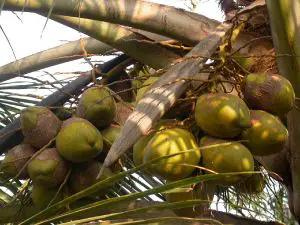
Pests and diseases
Coconuts are susceptible to the phytoplasma disease lethal yellowing. One recently selected cultivar, "Maypan," an F1 hybrid coconut of the Malayan Dwarf and the Panama Tall, has been bred for resistance to this disease. The fruit may also be damaged by eriophyid mites.
The coconut is also used as a food plant by the larvae of many Lepidoptera species, including the followingL Batrachedra spp: B. arenosella, B. atriloqua (feeds exclusively on Cocos nucifera), B. mathesoni (feeds exclusively on Cocos nucifera), and B. nuciferae.
The coconut hispine beetle or Brontispa longissima gestro feeds on young leaves and damages seedlings and mature coconut palms. On September 27, 2007, Philippines' Metro Manila and 26 provinces were quarantined due to having been infested with this pest to save the $800-million Philippine coconut industry (Remo 2007).
Uses
Nearly all parts of the coconut palm are useful, and the palms have a comparatively high yield (up to 75 fruits per year); it therefore has significant economic value. The name for the coconut palm in Sanskrit is kalpa vriksha, which translates as "the tree which provides all the necessities of life." In Malay, the coconut is known as pokok seribu guna, "the tree of a thousand uses." In the Philippines, the coconut is commonly given the title "Tree of Life."
To open a coconut, the softest "eye" should be pierced with a skewer and the water should be drained. Then the coconut should be struck against a hard surface, such as concrete or a kitchen surface. It should break open similarly to an egg, cracking in more than one place. However, quite a lot of force is required. An easier way is to drain the water, then wrap the coconut in a towel and hit it with a hammer. A third way to open a fresh coconut is to take a long, heavy, knife, such as a machete, and score a line across the middle of the coconut by repeatedly striking then rotating. The final stroke should be heavier than the previous to crack the coconut along the scored line. A final way is to just throw it up in the air and let it land on a hard surface. If done right, it should just crack open enough. To the inexperienced hand, tossing a coconut might end up in a messy affair.
Culinary Uses
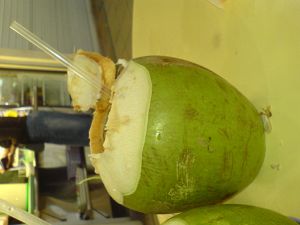
- The white, fleshy part of the seed is edible and used fresh or dried in cooking.
- Sport fruits are also harvested, primarily in the Philippines, where they are known as macapuno.
- The cavity is filled with coconut water which contains sugar, fiber, proteins, antioxidants, vitamins, and minerals. Coconut water provides an isotonic electrolyte balance, and is a highly nutritious food source. It is used as a refreshing drink throughout the humid tropics and is also used in isotonic sports drinks. It can also be used to make the gelatinous dessert nata de coco. Mature fruits have significantly less liquid than young immature coconuts; barring spoilage, coconut water is sterile until opened. It is also used in many tropical drinks, such as Piña Colada.
- Coconut milk is made by processing grated coconut with hot water or milk, which extracts the oil and aromatic compounds. It should not be confused with the coconut water discussed above, and has a fat content of approximately 17 percent. When refrigerated and left to set, coconut cream]] will rise to the top and separate out the milk.
- The leftover fiber from coconut milk production is used as livestock feed.
- The sap derived from incising the flower clusters of the coconut is fermented to produce palm wine, also known as "toddy" or, in the Philippines, tuba. The sap can also be reduced by boiling to create a sweet syrup or candy.
- Apical buds of adult plants are edible and are known as "palm-cabbage" or heart-of-palm. It is considered a rare delicacy, as the act of harvesting the bud kills the palm. Hearts of palm are eaten in salads, sometimes called "millionaire's salad."
- Ruku Raa (coconut nectar) is an extract from the young bud, a very rare type of nectar collected and used as morning break drink in the islands of Maldives reputed for its energetic power keeping the "raamen" (nectar collector) healthy and fit even over 80 and 90 years-old. And by-products are sweet honey-like syrup and creamy sugar for desserts.
- Newly germinated coconuts contain an edible fluff of marshmallow-like consistency called coconut sprout, produced as the endosperm nourishes the developing embryo.
- In the Phillipines, rice is wrapped in coco leaves for cooking and subsequent storage—these packets are called puso.
Non-culinary uses
- Coconut water can be used as an intravenous fluid (Campbell-Falck et al. 2000).
- Coir (the fiber from the husk of the coconut) is used in ropes, mats, brushes, caulking boats, and as stuffing fiber; it is also used extensively in horticulture for making potting compost.
- Copra is the dried meat of the seed and is the main source of coconut oil.
- The leaves provide materials for baskets and roofing thatch.
- Palmwood comes from the trunk and is increasingly being used as an ecologically-sound substitute for endangered hardwoods. It has several applications, particularly in furniture and specialized construction (notably in Manila's Coconut Palace).
- Hawaiians hollowed the trunk to form drums, containers, or even small canoes.
- The husk and shells can be used for fuel and are a good source of charcoal.
- Dried half coconut shells with husks are used to buff floors. In the Philippines, it is known as "bunot."
- In the Philippines, dried half shells are used as a music instrument in a folk dance called maglalatik, a traditional dance about the conflicts for coconut meat within the Spanish era
- Shirt buttons can be carved out of dried coconut shell. Coconut buttons are often used for Hawaiian Aloha shirts.
- The stiff leaflet midribs can be used to make cooking skewers, kindling arrows, or are bound into bundles, brooms and brushes.
- The roots are used as a dye, a mouthwash, and a medicine for dysentery. A frayed-out piece of root can also be used as a toothbrush.
- Half coconut shells are used in theater, banged together to create the sound effect of a horse's hoofbeats.
- The leaves can be woven to create effective roofing materials, or reed mats.
- Half coconut shells may be deployed as an improvised bra, especially for comedic effect or theatrical purposes.
- In fairgrounds, a "coconut shy" is a popular target practice game, and coconuts are commonly given as prizes.
- A coconut can be hollowed out and used as a home for a rodent or small bird. Halved, drained coconuts can also be hung up as bird feeders, and after the flesh has gone, can be filled with fat in winter to attract tits.
- Fresh inner coconut husk can be rubbed on the lens of snorkeling goggles to prevent fogging during use.
- Dried coconut leaves can be burned to ash, which can be harvested for lime.
- Dried half coconut shells are used as the bodies of musical instruments, including the Chinese yehu and banhu, and the Vietnamese đàn gáo.
- Coconut is also commonly used as a herbal remedy in Pakistan to treat bites from rats.
- The "branches" (leaf petioles) are strong and flexible enough to make a switch. The use of coconut branches in corporal punishment was revived in the Gilbertese community on Choiseul in the Solomon Islands in 2005 (Herming 2006).
- In World War II, coastwatcher scout Biuki Gasa was the first of two from the Solomon Islands to reach the shipwrecked, wounded, and exhausted crew of Motor Torpedo Boat PT-109 commanded by future U.S. president John F. Kennedy. Gasa suggested, for lack of paper, delivering by dugout canoe a message inscribed on a husked coconut shell. This coconut was later kept on the president's desk, and is now in the John F. Kennedy Library.
- Coconut trunks are used for building small bridges, preferred for their straightness, strength and salt resistance
Cultural aspects
Coconuts are extensively used in Hindu religious rites. Coconuts are usually offered to the gods, and a coconut is smashed on the ground or on some object as part of an initiation or inauguration of building projects, facility, ship, and so forth. This act signifies a sacrifice of ego, the idea that wealth stems from divinity, and the idea that, if due credit is not given, bad karma is taken on. In Hindu mythology it is referred as Kalpavruksha. In Hindu mythologies, it is said that Kalapavruksha gives what is asked for.
- The Indonesian tale of Hainuwele tells a story of the introduction of coconuts to Seram.
- The people of the state of Kerala in southern India consider Kerala to be the "Land of Coconuts"; nalikerathinte naadu in the native language.
- "Coconut" is New Zealand slang for a Tongan, or other person of "Polynesian" descent, although usually not Maori.
- Kurumba is used as a term for coconut (Maldives).
ReferencesISBN links support NWE through referral fees
- Adams, C. 2002. Are 150 people killed each year by falling coconuts? The Straight Dope. Retrieved October 17, 2007.
- Campbell-Falck, D., T. Thomas, T. M. Falck, N. Tutuo, and K. Clem. 2000. The intravenous use of coconut water. The American Journal of Emergency Medicine 18(1): 108.
- Figueiredo, C. de. 1940. Pequeno Dicionário da Língua Portuguesa. Lisboa: Livraria Bertrand.
- Herming, G. 2006. Wagina whips offenders. World Corporal Punishment Research. Retrieved October 17, 2007.
- Indian Association of Clinical Medicine (IACM). 1998. Coconut oil - ideal fat next only to mother's milk. Indian Academy of Clinical Medicine. Delhi: Indian Academy of Clinical Medicine. Retrieved October 21, 2007.
- NutritionData. 2007. Nutritional summary for vegetable oil, coconut. NutritionData. Retrieved October 21, 2007.
- Petroianu, G. A., M. Kosanovic, I. S. Shehatta, B. Mahgoub, A. Saleh, and W. H. Maleck. 2004. Green coconut water for intravenous use: Trace and minor element content. The Journal of Trace Elements in Experimental Medicine 17(4): 273.
- Ranti, I. S., K. Tien Boh, T. In Liang, and T. Eng Hoey. 1965. Coconut water for intravenous fluid therapy. Paediatrica Indonesiana 5(3).
- Remo, A. R. 2007. Beetles infest coconuts in Manila, 26 provinces. Inquirer.net. Retrieved October 21, 2007.
External links
All links retrieved January 7, 2024.
Credits
New World Encyclopedia writers and editors rewrote and completed the Wikipedia article in accordance with New World Encyclopedia standards. This article abides by terms of the Creative Commons CC-by-sa 3.0 License (CC-by-sa), which may be used and disseminated with proper attribution. Credit is due under the terms of this license that can reference both the New World Encyclopedia contributors and the selfless volunteer contributors of the Wikimedia Foundation. To cite this article click here for a list of acceptable citing formats.The history of earlier contributions by wikipedians is accessible to researchers here:
The history of this article since it was imported to New World Encyclopedia:
Note: Some restrictions may apply to use of individual images which are separately licensed.
